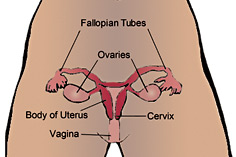|
|
|
|
|
The cervix, the lower part of the uterus or womb, is part of the female reproductive system. It connects the upper part of the uterus where a baby develops to the vagina or birth canal. During pregnancy the cervix remains tightly closed to hold the baby inside, but dilates or opens during childbirth to allow the baby to pass through.
|
 Source: American Cancer Society.
Source: American Cancer Society.
|
Cervical Cancer RISK FACTORS
|
- Human papillomaviruses (HPV)
- Lack of regular Pap tests
- HIV
- Age — cervical cancer is more common in women over the age of 40
- Sexual history — sex at a young age; sex with multiple partners; sex with a man who has had multiple partners
- Smoking
|
Cervical Cancer SIGNS AND SYMPTOMS
|
- Abnormal vaginal bleeding (between periods, after sex, after menopause)
- Increased vaginal discharge
- Pain in the pelvis
- Pain during sex
Source: “What You Need to Know about Cancer of the Cervix,” National Cancer Institute, Dec. 2004
|
Cervical Cancer SCREENING 101
|
- Get screened before you have symptoms
- Begin yearly Pap tests about 3 years after your first sexual intercourse, or when you reach 21, whichever is first
- Continue yearly Pap tests unless advised differently by your physician
Source: American Cancer Society, Cancer Facts and Figures 2006, Atlanta: American Cancer Society, 2006
|
|
|
|
